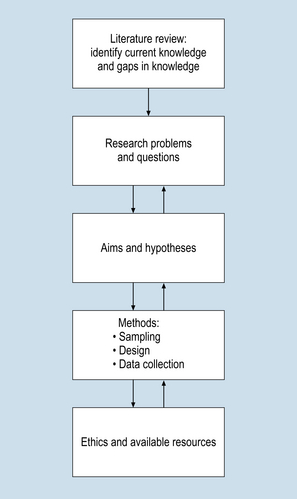4 The planning of a research study begins with the identification of a research problem, followed by the formulation of a research question. In the introduction of a research paper you will find the research question guiding the investigation. The formulation of a research question is the outcome of a complex, iterative process. Researchers refine and focus the question, as they plan the stages of the research project, as shown in Figure 4.1. There is a close relationship between the process of conducting research and the way in which research questions are formulated. The aims of this chapter are to: 1. Describe the process for identifying research problems. 2. Discuss the use of literature reviews for developing research questions. 3. Describe the relationship between formulating research questions and methodology. 4. Explain the relevance of ethics and resources to the statement of specific aims and hypotheses. As the biological and social environment changes, new health problems may emerge. For example, abundant food supplies and increasingly sedentary lifestyles have led to a high prevalence of obesity in some communities. Obesity is a serious risk factor for a numerous health problems including, type 2 diabetes and coronary heart disease. The research problem of interest to a researcher may be the lack of effective interventions for preventing and reducing obesity in the community. Another example is the health impact of climate change, a process which is predicted to impact on population health. The environmental changes (in particular the prediction of global warming) act as impetus to identifying new research problems as further research is required to provide the evidence. Many countries have research priorities based on the prevalence of diseases as identified by epidemiological studies (see Ch. 8). Public and political concern of the ‘burden of disease’ in a community may result in funding bodies preferentially channelling resources to researchers in these areas since the identified health problems are the most pressing and expensive to the communities in question. Economic pressures from increasing health costs require that service providers are accountable for the way in which they use available resources. Program evaluations for services are now routinely incorporated into service delivery. Evidence from this research is necessary to demonstrate that the resources are being used in the best way and that the services are meeting the needs of patients and the community. While often a source of stress for health professionals and administrators who participate in them, well-designed evaluation programs can contribute to the development of cost-effective, ‘value for money’ services to the community. For example, if you can demonstrate that program A and program B provide the same benefits but A costs half as much as B to deliver, then you will have made a significant contribution to health care. The money saved can be used to provide better services to other people.
The formulation of research questions
Introduction
Identifying research problems
Environmental and social changes
The cost-effectiveness of health services
![]()
Stay updated, free articles. Join our Telegram channel

Full access? Get Clinical Tree


Nurse Key
Fastest Nurse Insight Engine
Get Clinical Tree app for offline access

